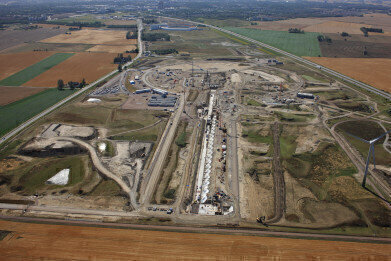-
 Aerial view of ESS construction site Lund
Aerial view of ESS construction site Lund
News & Views
World’s Biggest Microscope reaches Significant Milestone
Oct 23 2015
The European Spallation Source (ESS) celebrated an important milestone during September at its construction site in Lund, Sweden, where a celebration of its newly conferred status as European Research Infrastructure Consortium (ERIC) was undertaken. This new status establishes ESS as a major international scientific collaboration, putting it on a par with CERN and the European Southern Observatory. It also provides the ESS with a legal standing in all the Member Countries and provides the framework for completing the project in collaboration with the partners in those countries.
The European Commission's Director-General for Research and Innovation, Robert-Jan Smits handed over the official ‘plates’ of the ERIC from the Commission to ESS. He was joined by the Swedish Research Minister Helene Hellmark Knutsson and her Danish counterpart Esben Lunde Larsen, as well as representatives from the partner countries.
The European Spallation Source is the first ERIC established in Scandinavia and the eleventh in Europe. The establishment of the European Spallation Source ERIC provides ESS with legal status in all the Member Countries, enabling them to participate in the governance and directly contribute to financing ESS.
“The European Spallation Source is one of the most impressive European Research Infrastructures and has obtained the prestigious ERIC status,” said Robert-Jan Smits, the European Commission Director-General for Research and Innovation. “The timely completion of ESS enables Europe to maintain its position as the leader in neutron-based research and provides a multidisciplinary centre for innovation and competitiveness.”
The new facility is the world's next-generation neutron source and one of the highest priority research infrastructure projects in Europe. The EU has approved projects for ESS under its Horizon 2020 programme for €20 million. The project BrightnESS includes 18 European institutes and universities from 11 countries, over 36 months. It includes the Universities of Lund and Copenhagen, as well as CERN in Switzerland.
“Now we launch a new phase of the pan-European Partnership that is ESS, with an emphasis on the shared ownership of the project and the facility,” said Jim Yeck, ESS Director General. “The additional support through BrightnESS and other Horizon 2020 projects demonstrates the level of priority and commitment to making ESS a success.”
The European Commission confirmed the establishment of the European Spallation Source as an ERIC formally in mid-August, and the decision took effect as of the 31st of August. The Founding Members are the Czech Republic, Denmark, Estonia, France, Germany, Hungary, Italy, Norway, Poland, Sweden and Switzerland. Belgium, the Netherlands, Spain and the United Kingdom joined as Founding Observer Countries and plan to become Members in the near future. Greece also has indicated a wish to become an observer.
The European Spallation Source ESS AB was originally established as a Swedish limited liability corporation, owned by the Swedish and Danish governments. The company has now completed a transfer of assets, obligations and personnel to European Spallation Source ERIC.
Digital Edition
International Labmate 49.6 - Sept 2024
September 2024
Chromatography Articles - HPLC gradient validation using non-invasive flowmeters Mass Spectrometry & Spectroscopy Articles - From R&D to QC, making NMR accessible for everyone: Putting NMR...
View all digital editions
Events
Oct 30 2024 Birmingham, UK
Oct 30 2024 Manchester, UK
Nov 11 2024 Dusseldorf, Germany
Nov 12 2024 Cologne, Germany
Nov 12 2024 Tel Aviv, Israel


.jpg)















